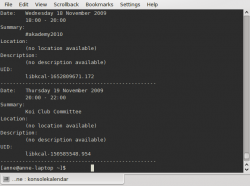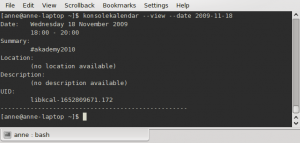KonsoleKalendar: Difference between revisions
m (Add Language Bar Template, simplify English) |
m (Fix spelling mistake: "us" -> "use") |
||
| (5 intermediate revisions by 2 users not shown) | |||
| Line 1: | Line 1: | ||
<languages /> | |||
<translate> | |||
<!--T:1--> | |||
{|class="tablecenter vertical-centered" | |||
|[[Image:Konsolekalendar-view.png|250px|thumb]]||'''Use your calendar when you can't use a graphical user interface''' | |||
|} | |||
<!--T:2--> | |||
'''konsolekalendar''' is an application to administer a calendar without a graphical user interface. It normally works with the calendar that is marked "Default", if you use '''KOrganizer'''. However, it is possible to create a calendar if you don't have one already. | |||
<!--T:3--> | |||
As it is strictly a command-line application, '''konsolekalendar''''s syntax must be learned first. | |||
<!--T:4--> | |||
Here is a short introduction to using '''konsolekalendar''': | |||
<!--T:5--> | |||
* If you do not already have a calendar set up, you first need to create one | |||
{{Input|1=konsolekalendar --create --file ~/.kde/share/apps/korganizer/vacation.ics}} | |||
<!--T:6--> | |||
(This location will enable it to be used either in '''konsolekalendar''' or in '''korganizer'''.) | |||
<!--T:7--> | |||
* Add a calendar entry | * Add a calendar entry | ||
{{Input|1=konsolekalendar --add --date 2009-06-06 --summary "My Birthday" \ | |||
--description "Party Time"}}adds your birthday to your default calendar. | |||
<!--T:8--> | |||
* Add a vacation | |||
{{Input|1=konsolekalendar --add --file vacation.ics --date 2009-08-01 \ | |||
--end-date 2009-08-07 --summary "Vacation" --description "Nobody will ever find me!"}} | |||
<!--T:9--> | |||
* Show all calendar entries | * Show all calendar entries | ||
{{Input|1=konsolekalendar --all 2>errorlog }} | |||
<!--T:10--> | |||
You probably don't want to do this, if you have been using your calendar for long. However, you can specify date ranges: | |||
{{Input|1=konsolekalendar --view --date 2009-08-17 --end-date 2009-08-21}}shows that particular work-week. | |||
<!--T:11--> | |||
* Maybe you only wanted to see the next entry? | |||
{{Input|1=konsolekalendar --next}} | |||
<!--T:12--> | |||
* Or for the week ahead? | |||
{{Input|1=konsolekalendar --show-next 7}} | |||
<!--T:13--> | |||
* Show your calendar file | * Show your calendar file | ||
{{Input|1=konsolekalendar --view 2>&1 {{!}} grep resource {{!}} grep konsolekalendar}} | |||
<!--T:14--> | |||
* Edit an entry | |||
{{Input|1=konsolekalendar --change --uid libkcal-1652809671.172 --summary "Get my head examined" --description "I must be crazy!!"}} | |||
<!--T:15--> | |||
* Before you can delete an entry, you first need to list it: | |||
[[Image:Konsolekalendar-list.png|300px|center]] | |||
<!--T:16--> | |||
There at the bottom is the UID of the entry. | |||
<!--T:17--> | |||
Now you are ready to delete it - | |||
{{Input|1=konsolekalendar --delete --uid libkcal-1652809671.172}} | |||
<!--T:18--> | |||
{{Warning|Beware - this is a permanent delete. You cannot recover the entry }} | |||
<!--T:19--> | |||
* Export a calendar | |||
It is possible to export to several formats, including ''CSV'' and ''html''. | |||
{{Input|1=konsolekalendar --export-type CVS current.ics}} | |||
<!--T:20--> | |||
* Import a calendar | |||
{{Input|1=konsolekalendar --import another.ics --file current.ics}} | |||
<!--T:21--> | |||
In this case, all the entries from another.ics will be merged into current.ics. | |||
<!--T:22--> | |||
[[Category:Office]] | |||
</translate> | |||
Latest revision as of 06:04, 7 February 2022
 |
Use your calendar when you can't use a graphical user interface |
konsolekalendar is an application to administer a calendar without a graphical user interface. It normally works with the calendar that is marked "Default", if you use KOrganizer. However, it is possible to create a calendar if you don't have one already.
As it is strictly a command-line application, konsolekalendar's syntax must be learned first.
Here is a short introduction to using konsolekalendar:
- If you do not already have a calendar set up, you first need to create one
konsolekalendar --create --file ~/.kde/share/apps/korganizer/vacation.ics
(This location will enable it to be used either in konsolekalendar or in korganizer.)
- Add a calendar entry
konsolekalendar --add --date 2009-06-06 --summary "My Birthday" \ --description "Party Time"
adds your birthday to your default calendar.
- Add a vacation
konsolekalendar --add --file vacation.ics --date 2009-08-01 \ --end-date 2009-08-07 --summary "Vacation" --description "Nobody will ever find me!"
- Show all calendar entries
konsolekalendar --all 2>errorlog
You probably don't want to do this, if you have been using your calendar for long. However, you can specify date ranges:
konsolekalendar --view --date 2009-08-17 --end-date 2009-08-21
shows that particular work-week.
- Maybe you only wanted to see the next entry?
konsolekalendar --next
- Or for the week ahead?
konsolekalendar --show-next 7
- Show your calendar file
konsolekalendar --view 2>&1 | grep resource | grep konsolekalendar
- Edit an entry
konsolekalendar --change --uid libkcal-1652809671.172 --summary "Get my head examined" --description "I must be crazy!!"
- Before you can delete an entry, you first need to list it:

There at the bottom is the UID of the entry.
Now you are ready to delete it -
konsolekalendar --delete --uid libkcal-1652809671.172
- Export a calendar
It is possible to export to several formats, including CSV and html.
konsolekalendar --export-type CVS current.ics
- Import a calendar
konsolekalendar --import another.ics --file current.ics
In this case, all the entries from another.ics will be merged into current.ics.

